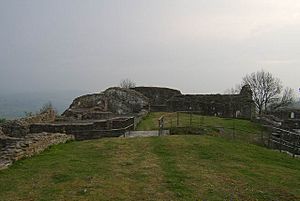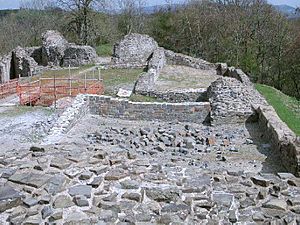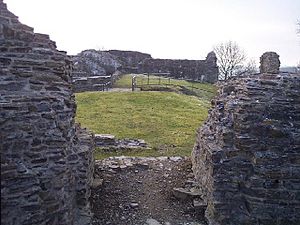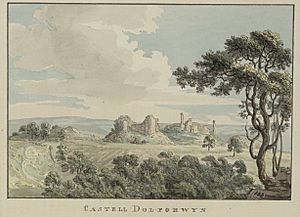Dolforwyn Castle facts for kids
Quick facts for kids Dolforwyn castle |
|
|---|---|
| Castell Dolforwyn | |
| Abermule, Powys | |

Inner wards of Dolforwyn Castle, c.2007.
|
|

A view towards the castle inner ranges and NE round tower.
|
|
| Coordinates | 52°32′46″N 3°15′07″W / 52.5462°N 3.252°W |
| Type | Welsh Enclosure castle |
| Site information | |
| Controlled by | Cadw |
| Open to the public |
Yes |
| Condition | Ruined |
| Site history | |
| Built | 1273 - 1277 |
| Built by | Llywelyn ap Gruffudd |
| Materials | Stone |
| Events | Welsh Wars |
Dolforwyn Castle (which means Castell Dolforwyn in Welsh) is a Welsh medieval castle. It stands high above the village of Abermule in Powys, Wales. Llywelyn ap Gruffudd, who was the Prince of Gwynedd, built this strong castle in the late 1200s. It sits on a wooded hill with amazing views of the upper Severn Valley.
Dolforwyn Castle is a great example of a Welsh-built castle. It is different from the castles the English built during their conquests of Wales.
Contents
History of Dolforwyn Castle
Building a Welsh Castle
Llywelyn ap Gruffudd, the Prince of Gwynedd, mainly ruled over lands in Gwynedd. He wanted to show that he was the most important Welsh prince. To do this, he needed to control the Severn Valley, which was a key area. This valley offered a way into the heart of Wales.
In 1257, Llywelyn took over this area. By 1263, he had captured the regions known as Cedewain and Ceri. Because of this, King Henry III of England recognized Llywelyn as the Prince of Wales. This happened under the Treaty of Montgomery in 1267. To make his new lands secure, Llywelyn ap Gruffydd built Dolforwyn Castle. He built it between 1273 and 1277. It cost about £174, which was a lot of money back then!
The castle was quite simple compared to other castles of its time. Workers carved a flat area out of the rock, about 240 feet long and 90 feet wide. The first castle had a square tower at one end and a round tower at the other. Later, walls were built to connect these towers. This created a rectangular area with a D-shaped tower on the north wall. A ditch cut into the rock divided the inside area into two parts. A two-story building was also built against the north wall. The main entrance was on the west side. A smaller entrance was on the south side.
How the Castle Was Captured
Llywelyn built Dolforwyn Castle without asking the new English king, Edward I. King Edward's own castle was nearby at Montgomery Castle. This made things tense between Llywelyn, King Edward, and Gruffydd ap Gwenwynwyn. Gruffydd was the Prince of Southern Powys. He owned Powis Castle near Welshpool.
In 1277, soon after Dolforwyn Castle was finished, Roger Mortimer and Henry de Lacy, Earl of Lincoln attacked it. The castle fell on April 8, 1277. This happened because the people inside ran out of water. There was no well built inside the castle.
First, Gruffydd ap Gwenwynwyn was given control of the castle. But later, Roger Mortimer took over, along with the lands of Ceri and Cedewain. After the English captured it, they changed the castle's design. They blocked the south gate. New buildings were put up in the courtyard. And finally, a well was dug to provide water!
After Roger Mortimer died in 1282, his son Edmund took over the castle. Then it went to Edmund's son, Roger Mortimer, 1st Earl of March. This Roger lost the family's lands in 1322 because of treason. At that time, a list of the castle's rooms was made. It showed an armoury (for weapons) in the round tower. There were also living areas with a pantry, kitchen, and a chapel. It even had a hall, a lady's room, and two barns for storing grain.
Later Years of the Castle
Dolforwyn Castle was likely used until the time of King Richard II (1377–99). But by 1381, people already said it was in bad shape. By 1398, it was called "ruinous and worth nothing." After this time, the castle was almost forgotten. No one seemed very interested in it.
The castle eventually belonged to the Earl of Powis. Later, the grandfather of a historian named John Davies Knatchbull Lloyd bought it. In 1955, he gave the site to the Welsh Ancient Monuments Board, which is now called Cadw. Cadw arranged for people to dig up the site between 1981 and 2002. Today, the castle ruins are open for everyone to visit.
In June 2009, Cadw started a six-month project. They worked to make the castle walls stronger and safer.
Castle Stories and Books
According to old stories, a maiden named Sabrina drowned at Dolforwyn. She then became the goddess of the River Severn. The name Dolforwyn means "maiden's meadow," which might be linked to this myth.
John Milton, a famous writer, wrote about the goddess Sabrina in his play Comus. This play was performed in 1645. He wrote:
- Sabrina fair
- Listen where thou art sitting
- Under the glassie, cool, translucent wave,
- In twisted braids of lillies knitting
- The loose train of thy amber-dripping hair,
- Listen for dear honour's sake
- Goddess of the silver lake."
The author Bernard Cornwell also used Dolforwyn Castle in his book The Winter King, which is part of The Warlord Chronicles series.
Studying the Castle's Past
The entire site of Dolforwyn Castle was carefully dug up by archaeologists. This project happened between 1981 and 2002. It was a joint effort between the University of Leeds (1981-1985), the University of York (1986-2002), and Cadw. For over twenty years, students and Cadw workers spent a few weeks each summer exploring different parts of the castle. Dr. Lawrence Butler led this important work. Local builders hired by Cadw also helped to repair the castle walls.
During these digs, many interesting things were found. These included part of a leather book cover and a small dice. They also found a silver coin from the time of King Edward II. A large number of stone catapult balls were also found. These were likely used by the English during their attack in 1277.
Workers removed over 15 metres (about 50 feet) of dirt and rubble to uncover the castle's features. They found a small stone hall. They also saw English repairs to the Welsh walls, which looked different because of the mortar used. They found what might have been an oven for drying wheat. There was also a 6-metre (about 20-foot) deep cistern or well.




